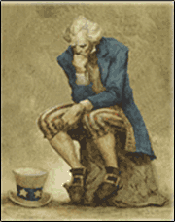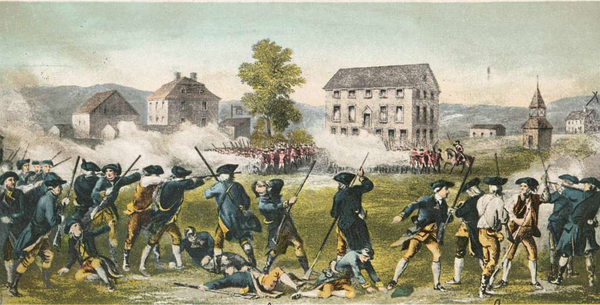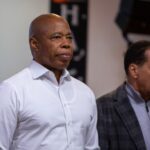
–>
April 19, 2023
The study of history gives perspective on our present world. Consider the events leading to the American Revolution. In 1763, after decades of on again, off again war, British forces decisively defeated the French to conclude the Seven Years War, leaving them a virtually invincible empire, with the strongest navy, the largest merchant fleet, and the fastest-growing economy in the world.
‘); googletag.cmd.push(function () { googletag.display(‘div-gpt-ad-1609268089992-0’); }); }
However, during the later 1760s and early 1770s, relations between Great Britain and her American colonies grew steadily worse. The Stamp Act of 1765, the occupation of Boston in 1768, the Boston Massacre of 1770, and the Tea Party of 1773, had enflamed passions on both sides of the Atlantic.
In 1774, Parliament, with King George III’s consent, passed the Massachusetts Government Act of Great Britain, transferring most of the powers of the colony’s elected government to the royal governor, General Thomas Gage. Fearing the outbreak of violence, Gage began to confiscate military supplies, principally gunpowder, from the militia.
By April 1775, the provincials had for some time been hiding weapons and powder at various locations, including the town of Concord, some twenty miles west of Boston. On the 18th of April, Gage dispatched about 700 infantry, all British regulars under the command of Lieutenant Colonel Francis Smith, to seize the munitions there. Despite the general’s attempts to maintain secrecy, Paul Revere and others brought news of the raid to Lexington shortly after midnight.
‘); googletag.cmd.push(function () { googletag.display(‘div-gpt-ad-1609270365559-0’); }); }
As word of the approaching troops went out through the surrounding countryside, Captain John Parker and some seventy to eighty militia gathered near the town meeting house and waited for the redcoats. Knowing the munitions at Concord had been safely moved to other locations, Parker had no intention of engaging the British troops and ordered his men “don’t fire unless fired upon.” He and his men lined up on Lexington Common in a show of resolve, expecting the redcoats to continue to Concord without hostilities. Tension was high as the two groups faced off.
The question of who fired first has long engaged historians. Participants on both sides were adamant that the other initiated hostilities, but it is unlikely the matter can ever be settled. What we do know is that a sound like a gunshot was heard and it was spark enough to cause the British troops to fire without orders. Their officers tried immediately to halt the unauthorized attack. So rapidly did matters escalate that few militiamen managed to fire their weapons in the skirmish, which left eight Americans dying. Most of the provincials scattered in the face of the much larger force opposing them.
Once Smith, the British commander, had regained control of his troops, he regrouped and pressed on to Concord. Upon arriving there he assigned about ninety men to guard the way back to Boston, in particular the North Bridge which spanned the Concord River outside of the town. Another group he sent to search the farm of provincial Colonel James Barrett for munitions, almost all of which had been removed previously. Barrett himself was in command of the militia on Punkatasset Hill, overlooking the bridge. His numbers grew steadily as militiamen arrived from neighboring towns, reaching a force of some 400 armed men.
 Seeing smoke rise from Concord, Barrett and his officers grew concerned the British troops were burning the town to the ground, although such was not the case. Barrett’s troops advanced to the bridge and began to cross it. Again, tense men facing one another led to someone firing a shot, followed by another until both sides fired volleys across the bridge at one another. Within three minutes the action was over, but several men lay dead or wounded. Outnumbered and low on ammunition, the British troops retreated into town.
Seeing smoke rise from Concord, Barrett and his officers grew concerned the British troops were burning the town to the ground, although such was not the case. Barrett’s troops advanced to the bridge and began to cross it. Again, tense men facing one another led to someone firing a shot, followed by another until both sides fired volleys across the bridge at one another. Within three minutes the action was over, but several men lay dead or wounded. Outnumbered and low on ammunition, the British troops retreated into town.
Fortunately for the British, Gage had sent a relief force of about 1,000 infantry under the command of General Hugh Percy and the two groups met at Lexington. Together they marched back to Boston in a bloody retreat which saw many casualties. Total American casualties (killed, wounded, and missing) were 95, versus 273 for the British. By the morning of April 20, some 15,000 provincial troops held Boston under siege.
The events of April 19, 1775 rocked the world of the colonists. It would not be until sixty-three years later Ralph Waldo Emerson would declare the battle to be the “shot heard round the world,” but it was evident to all who survived the day that something fundamental in the world had changed. Unlike previous incidents, such as the Boston Massacre, for the first time British and American forces had fought and killed one another. Few, if any, could foresee it would take eight years, until the signing of the Treaty of Paris (1783), to finally settle the matter of American independence from Great Britain.
‘); googletag.cmd.push(function () { googletag.display(‘div-gpt-ad-1609268078422-0’); }); } if (publir_show_ads) { document.write(“
Today, one often hears or reads laments about life “in these uncertain times.” But what times are certain? While some periods are relatively more peaceful and prosperous than others, in every time there are doubts about what comes next. In our own time, there are many reasons for concern: Russia’s invasion of Ukraine; the growing strength and aggression of China; cultural unrest in America dividing the country along fault lines of politics, race, and sex; failures of major banks; and so on.
However, as bestselling author David McCullough has noted, “One might also say that history is not about the past. If you think about it, no one ever lived in the past. Washington, Jefferson, John Adams, and their contemporaries didn’t walk about saying, “Isn’t this fascinating living in the past! Aren’t we picturesque in our funny clothes!” They lived in the present. The difference is it was their present, not ours. They were caught up in the living moment exactly as we are, and with no more certainty of how things would turn out than we have.”
No certainty, just the necessity to live in the present while trying to shape a better future for those who come after us. One lesson of April 19, 1775 is that we should take heart from the experiences of our ancestors. Out of their struggles came, in the words of Lincoln, “a new nation, conceived in liberty.” Our present challenges are real, but let us not imagine they are unprecedented. Rather, let us take courage from the example of those who came before us.
Harold Lowery is the author of the historical novel From Lexington to Yorktown.
Image: New York Public Library
<!– if(page_width_onload <= 479) { document.write("
“); googletag.cmd.push(function() { googletag.display(‘div-gpt-ad-1345489840937-4’); }); } –> If you experience technical problems, please write to [email protected]
FOLLOW US ON
<!–
–>
<!– _qoptions={ qacct:”p-9bKF-NgTuSFM6″ }; ![]() –> <!—-> <!– var addthis_share = { email_template: “new_template” } –>
–> <!—-> <!– var addthis_share = { email_template: “new_template” } –>





